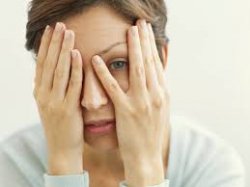Here you can add a link to a video
Anxiety is distinguished from fear which is an appropriate cognitive and emotional response to a perceived threat. Anxiety is related to the specific behaviors of fight-or-flight responses defensive behavior or escape. It occurs in situations only perceived as uncontrollable or unavoidable but not realistically so.[11] David Barlow defines anxiety as "a future-oriented mood state in which one is not ready or prepared to attempt to cope with upcoming negative events"[12] and that it is a distinction between future and present dangers which divides anxiety and fear. Another description of anxiety is agony dread terror or even apprehension.[13] In positive psychology anxiety is described as the mental state that results from a difficult challenge for which the subject has insufficient coping skills.[14]
Here you can add a link to a video
The philosopher Søren Kierkegaard in The Concept of Anxiety (1844) described anxiety or dread associated with the "dizziness of freedom" and suggested the possibility for positive resolution of anxiety through the self-conscious exercise of responsibility and choosing. In Art and Artist (1932) the psychologist Otto Rank wrote that the psychological trauma of birth was the pre-eminent human symbol of existential anxiety and encompasses the creative person's simultaneous fear of – and desire for – separation individuation and differentiation.
Here you can add a link to a video
According to Yerkes-Dodson law an optimal level of arousal is necessary to best complete a task such as an exam performance or competitive event. However when the anxiety or level of arousal exceeds that optimum the result is a decline in performance.[22]
Test anxiety is the uneasiness apprehension or nervousness felt by students who have a fear of failing an exam. Students who have test anxiety may experience any of the following: the association of grades with personal worth; fear of embarrassment by a teacher; fear of alienation from parents or friends; time pressures; or feeling a loss of control. Sweating dizziness headaches racing heartbeats nausea fidgeting uncontrollable crying or laughing and drumming on a desk are all common. Because test anxiety hinges on fear of negative evaluation[23] debate exists as to whether test anxiety is itself a unique anxiety disorder or whether it is a specific type of social phobia.[24] The DSM-IV classifies test anxiety as a type of social phobia.[25]
Here you can add a link to a video
Humans generally require social acceptance and thus sometimes dread the disapproval of others. Apprehension of being judged by others may cause anxiety in social environments.[28]
Anxiety during social interactions particularly between strangers is common among young people. It may persist into adulthood and become social anxiety or social phobia. "Stranger anxiety" in small children is not considered a phobia. In adults an excessive fear of other people is not a developmentally common stage; it is called social anxiety. According to Cutting[29] social phobics do not fear the crowd but the fact that they may be judged negatively.




gg